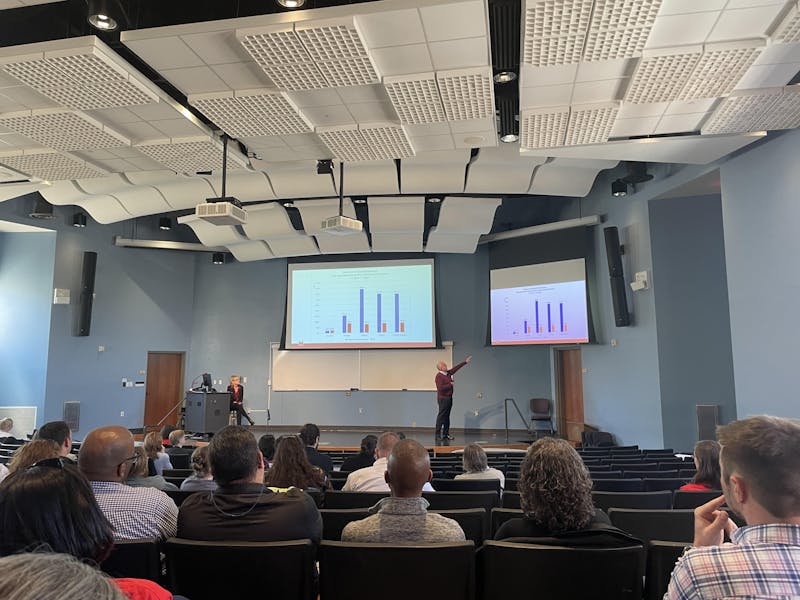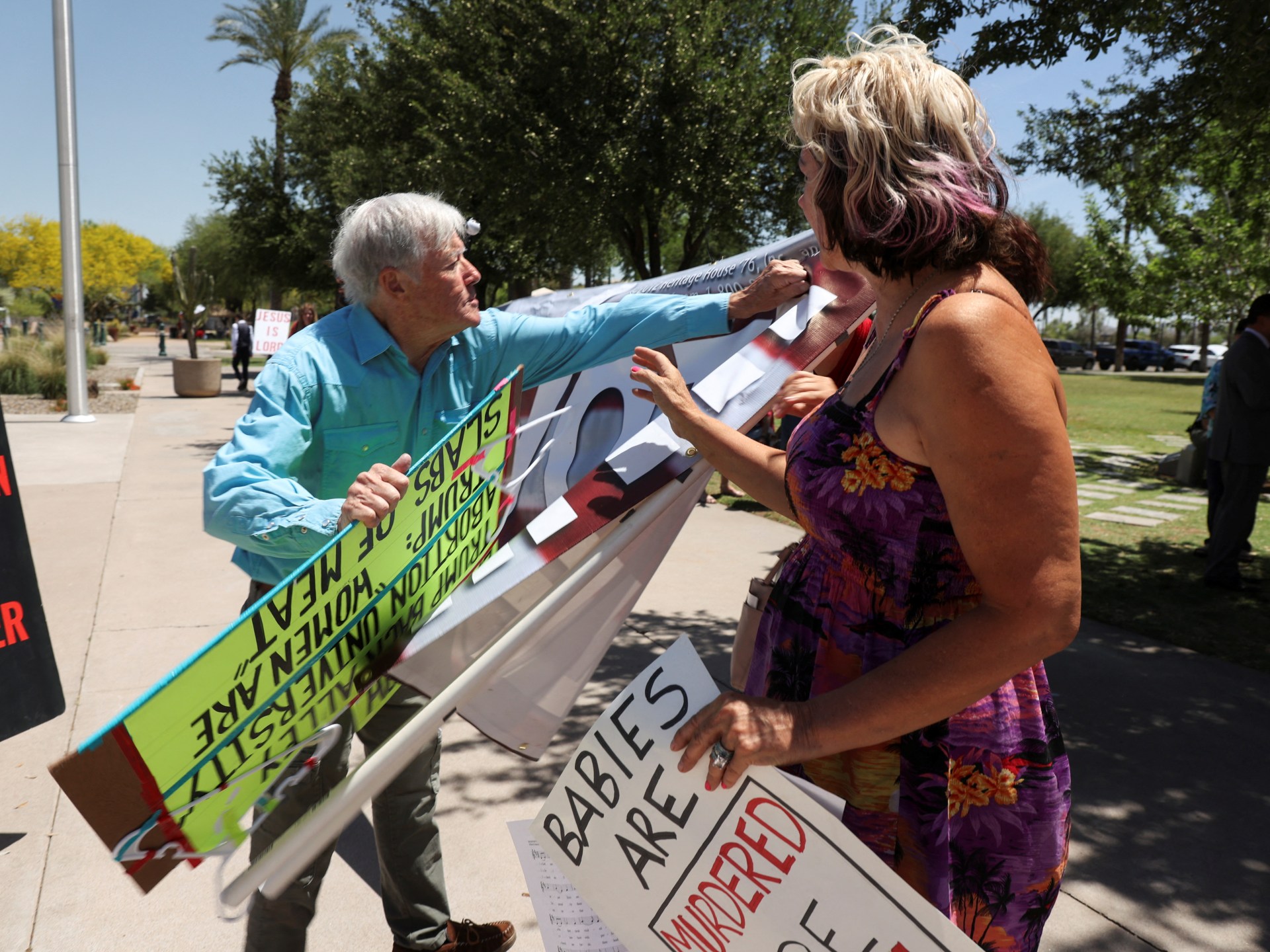Finance
Abortion-rights amendment backers want rewrite of finance info on ballot that's now 'outdated' • Florida Phoenix

Within days of a momentous Florida Supreme Court ruling authorizing a referendum to restore abortion rights, the group pushing the initiative rushed to file a lawsuit to ensure that the ballot language describing its financial implications doesn’t mislead voters.
Floridians Protecting Freedom, sponsor of the proposed Amendment 4, claims the financial impact statement now planned “is fatally flawed.”
“First, it largely presents outdated information about the legality of abortion under statutes and litigation unrelated to Amendment 4; second, the inclusion of such information renders it confusing, ambiguous, and misleading; and third, it highlights the potential of future litigation, which is speculative,” the organization said in a 17-page civil complaint filed Friday in Leon County Circuit Court, in Tallahassee.
“Because the [financial estimate] is unclear, confusing, ambiguous, misleading, and inaccurate, voters will be prevented from casting an informed ballot,” the document adds.
In a written statement to the Phoenix, the campaign appeared to play down the significance of the lawsuit, saying the Financial Impact Estimating Conference (FIEC), which drafted the impact statement last November, needs a court order to revise it.
“This is a technical issue, and we look forward to working with the FIEC to resolve it, so voters have accurate information when it comes time to vote on Amendment 4,” the organization said in its statement.
Still, unless the amendment passes (with the constitutionally required 60% of the votes cast), Florida will continue to enforce a draconian ban on abortions conducted after six weeks’ gestation, before many people realize they are pregnant. The ban is set to take effect on May 1.
This appears to be the first time such a situation has arisen, the campaign continued. That’s because on April 1, the same day the court OK’d the initiative for the ballot, it also reversed its own 1989 precedent that the Florida Constitution’s Privacy Clause protects access to abortion. That ruling triggered the countdown to the six-week ban.
Of course, there was no way nearly five months ago for the FIEC to anticipate that ruling, especially in light of the then-pending challenge to the state’s abortion limits, so its members hedged their bets, concluding: “Because there are several possible outcomes related to this litigation that differ widely in their effects, the impact of the proposed amendment on state and local government revenues and costs, if any, cannot be determined.”
The abortion ban ruling, then, “has rendered the current financial impact language outdated and no longer accurate. To our knowledge, this is the first time it has happened that a court ruling following the determination of a financial impact has rendered the financial impact statement inaccurate,” Floridians Protecting Freedom told the Phoenix.
Economic experts
The conference is a collection of economic experts that regularly advises state government. The suit names the panel plus its four members — Amy Baker, director of the state Office of Economic and Demographic Research, Vince Aldridge, staff director for the House Ways and Means Committee; Azhar Khan, staff director of the Senate Finance and Tax Committee; and Brea Gelin, a chief analyst in the Executive Office of the Governor — plus Secretary of State Cord Byrd.
“Under current statutes, the FIEC may not be able to reconsider the financial impact statement without a court order, so Floridians Protecting Freedom is filing a lawsuit, simply to compel the state to ensure the financial impact statement accompanying the ballot summary of Amendment 4 is accurate. This is a technical issue, and we look forward to working with the FIEC to resolve it, so voters have accurate information when it comes time to vote on Amendment 4,” the campaign told the Phoenix.
As with all proposed constitutional amendments, the financial estimate will appear on the ballot along with a summary of what any amendments would do. The idea is to give voters the best possible assessment of how an initiative would affect taxpayers.
That existing language won’t do, the new lawsuit complains:
“First, it largely presents outdated information about the legality of abortion under statutes and litigation unrelated to Amendment 4; second, the inclusion of such information renders it confusing, ambiguous, and misleading; and third, it highlights the potential of future litigation, which is speculative.”
Fresh language
The text of the proposed “Amendment to Limit Government Interference with Abortion” says: “Limiting government interference with abortion. — Except as provided in Article X, Section 22, no law shall prohibit, penalize, delay, or restrict abortion before viability or when necessary to protect the patient’s health, as determined by the patient’s healthcare provider.”
Now that the state Supreme Court has settled the ambiguities the group wrestled with, the financial statement needs rewriting, the complaint says.
“The 6-week ban will be in effect at the time of the election, so to accurately reflect Amendment 4’s probable financial impact, the [impact statement] must reflect that reality,” it notes.
It suggests fresh language:
“The Florida Financial Impact Estimating Conference estimated that this proposed amendment will result in decreased costs to state government, no impact to local government revenues or costs, and an overall positive impact to the state budget.”
Floridians Protecting Freedom asked for a quick ruling.
“Time is of the essence, and this matter should be expedited because the ballots for the 2024 General Election will be mailed to voters starting as early as September 21, 2024. … The ballot’s design must necessarily be finalized, and the ballots themselves printed, before then,” the complaint argues.
According to conference’s analysis, the state recorded 46,011 abortions up to six weeks’ gestation during 2022, or 55.7% of the total of 82,851 that year. There were 81,269 conducted up to 15 weeks’ gestation.
For that reason, the document forecasts broader savings for state and local governments if the amendment passes while the six-week ban remains law, because there would be fewer children going to school, participating in social services, or otherwise drawing tax money. But it gives no hard numbers.
“The FIEC has already developed the financial impact analysis for a scenario that the 6-week ban is in place — Florida’s current reality — so they do not need to revisit their analysis. However, their summary of that impact, which all voters will see, is now inaccurate and needs to be updated to reflect the current reality,” the organization told the Phoenix.

Finance
What will the finance team of the future look like – Accountancy Age

Author
Date published
May 2, 2024
Categories
A significant part of the work we do at AICPA & CIMA is about looking at trends within the profession and using them to discern what the future of accounting looks like, so as to best prepare our members to thrive within it.
This is the rationale behind our Future of Finance 2.0 project, of which we have just released the latest iteration. This paper highlights and explores what I think is the most significant long-term trend which is currently reshaping the accounting and finance profession, and it essentially relates to mindset.
In the past, it would be fair to characterise our profession as being quite rigid and rules based. This is not intended to be derogatory, it is simply a reflection of the work we did and the career paths we followed to do it. What we are seeing today, and will see more of in the future, is a shift towards a more expansive mindset, with value-creation at its heart.
Our work will incorporate a wider range of responsibilities, including but not limited to being the stewards of sustainability data and strategy and working with colleagues in all parts of the of organisations we serve to drive efficiency, productivity and sustainable value creation.
Sustainability
Sustainability is one of the key drivers of change within the profession, but it is important to understand that this is not just a response to regulatory changes which require us to present the data. While these are obviously important, it is important to look beyond this, and to apply the value creation mindset I have mentioned, because this is where the opportunities are.
Forward thinking organisations are not approaching this in terms of “we have to report”. They are looking at how their business models can adapt to produce truly sustainable growth, because that is where competitive advantage will be found.
Now clearly, that is not a description of the majority of workplaces at the moment, but you can see evidence of the direction of travel in our survey results. We found that 48% of accounting and finance professionals are currently measuring the impact of sustainable initiatives and only 45% say that they are currently measuring the performance of these initiatives. That is a significant proportion, and the fact that more and more companies are looking at the performance of these initiatives shows you where we are heading.
Business partnering is the way of the future
Another big change our research picked up was the increasing move towards the business partnering model. Something which struck me as very significant was the difference in attitudes towards the future we found among the professionals we surveyed. 60% of them said they identify as finance business partners, and 84% of those are extremely optimistic about the future of the profession. Of the 40% who say they don’t identify as finance business partners, only 15% said they are optimistic about the future of the profession. I think that is a pretty good indication of where our profession is heading, so I strongly recommend you take that into account in your career planning.
To make the most of this trend, the accountants of the future will need the ability to use data and analytics combined with business acumen, so they can improve strategic decision-making and drive business performance within their organisations.
Overall the challenge for the profession which our research identified is the need to adapt to the requirements of sustainable business practice while exploiting the possibilities of new technology. To succeed we will have to adopt a multi-capital perspective of value while learning to work across organisational boundaries. If we can achieve this, we can look forward to a bright future. Demand for data-driven decision-making and sustainable business models is only going to grow, so we can be confident that the need for strategic value creating finance teams will make us a valuable partner in every organisation in the years to come.
Subscribe to get your daily business insights
Finance
Belvedere finance committee previews draft budget

Belvedere’s growing fire service expenses in the proposed draft budget for next fiscal year have raised concerns among the city’s finance committee.
The committee reviewed the $9 million draft budget on Tuesday. The 2024-2025 budget proposal shows a $1.2 million general fund deficit by the end of June 2025.
City staff said there may be some small growth in revenues and a slight increase in spending, particularly with the city’s fire services contract.
General fund revenues are projected to be $9.1 million, but the city’s expenses and outgoing transfers add up to $10.3 million — a 5.8% increase over the current year budget. Transfers to various funds include $300,000 to pension trusts and $650,000 to critical infrastructure.
Helga Cotter, director of administrative services, said they expect to close out the current fiscal year with an excess of $1.4 million, which would cover the deficit.
“It is also important to note that some of these transfers out are not associated with current year expenses,” Cotter said. “Specifically the critical infrastructure reserve and the 115 pension trust fund transfers are being made to fund anticipated future expenses, allowing budget smoothing.”
Most of the city’s income is earmarked for costs relating to fire protection, police services and the department of public works, according to the draft budget. Around $1.1 million is planned for capital projects, which includes the seawall and retaining wall projects.
Robert Zadnik, the city manager, said the retaining walls along Beach Road are particularly concerning and a No. 1 priority; $175,500 is set aside for the project in the draft budget. However, Zadnik said the current solution proposed by engineering experts does not address seismic concerns.
“This isn’t something new that was a surprise to us,” Zadnik said. “We’ve known through the committee to protect Belvedere seawalls, levees and utilities that this was a vulnerability, a threat.”
The majority of the city’s revenue, 71%, comes from property taxes. Cotter said the property tax forecast shows a potential 5% increase, equal to $358,000, for the budget year, and that revenues in the general fund could increase 2%, or about $177,000. No grant funding is included in the draft budget, but Cotter said the city will continue to look for grant opportunities.
A significant change in costs is a 7.5% increase in Tiburon Fire Protection District’s contract. The fire service deferred some of its annual Section 115 contributions — a trust account needed to fund employee benefits — to keep a fairly consistent cost to the city. Without this, the increase to the budget would have been approximately 14%. Still, the city anticipates a payment to the district of over $92,500, and will make an additional payment in the future.
Currently the fire service contract is around $2.1 million, but is expected to increase to $2.4 million in the next budget cycle.
Sally Wilkinson, a nonvoting City Council member on the committee, said fire expenses have been growing about 6% annually for the past 20 years, while the city’s expenditures have grown at 4.4%. She suggested closely analyzing the long-term trends in cost over the past years — and the projected increases in the future.
“I think it would be useful just to distribute some numbers and some charts just to give a clearer impression of where that has gone and, as you say, project it out 20 years just to see when that crunch really hits,” Wilkinson said.
Other expenses include a one-time payment for the Martha property of $125,000, adjusting city staff salaries for cost of living by 3% for the budget year, and housing element legal costs.
Capital improvement expenditures include projects throughout Belvedere, such as road maintenance including pavement repairs, crack sealing, and traffic marking; emergency preparedness work like vegetation and fire fuel reduction throughout the city; and technology upgrades.
Cotter said the city plans to make a payment of about $250,000 in pension related debt, but unfunded accrued liability payments to CalPERS are expected to increase over the next five years. While the city plans to continue the around $300,000 per year in debt payment, the budget expects the required pension contributions to rise from $195,000 in in fiscal year 2025 to $415,000 in budget year 2029.
Zadnik said the total remaining pension debt at the end of this fiscal year will be $1.6 million.
The budget forecast meets the city’s reserve goals. Belvedere’s policy is to have equal to half of the general fund expenses, plus the pension debt and fire services cost. Reserves are meant to cover around six months of operating costs in the event of a catastrophic event. The draft budget leaves Belvedere $150,0911 over the amount required by policy.
“What worries me is this budget is in deficit,” said John Wilton, a member of the committee. “This is one of the only years we’re running a pretty significant deficit.”
Wilton said he would like more explanation behind how the five-year projections do not show a continued or increased deficit, and asked staff to show how they were going to “turn it around.”
The City Council is scheduled to review the draft budget at its May 13 meeting. A public hearing is set for June 10. The new fiscal year begins on July 1.
Finance
Sen. Whitehouse: Climate change could crash the financial system

The Hill reported earlier this month on how opaque decisions within the insurance industry were laying the groundwork for where Americans will live as the planet heats.
But the risk goes beyond that, many experts warn: The complex interrelationships between insurance, mortgage lending and the broader financial system have made climate change “an emerging risk to financial stability,” according to the 2023 report by the Financial Stability Oversight Committee.
Senate Budget Committee Chair Sheldon Whitehouse (D-R.I.) has been a principal voice warning of the financial risks spilling over as climate change impacts the insurance industry.
Sen. Whitehouse sat down with The Hill to discuss why he worries climate change poses risk to the global financial system and the role of the Senate in addressing it.
Q: Some experts warn about the potential of Great Recession-style systemic risk from climate insurance — but others argue that, however serious that risk might be, it’s fundamentally a regional issue, restricted to places like Florida. Which side of that do you come down on?
Whitehouse: There are very significant indicators and it’s going to be big, national, and even global. A number of studies show a very high risk to the world economy from calamities — and insurance is at the heart of that.
The Florida insurance market is more or less circling the drain right now in the way in which Freddie Mac’s chief economist predicted: that with the danger of sea level rise and coastal storm activity, coastal properties become increasingly expensive to insure and then they become uninsurable.
And once they become uninsurable, they become unmortgageable. And once buyers can’t get mortgages for those properties, the values crash — because you’ll now only have cash buyers on the demand side.
And that was predicted by Freddie Mac to produce a systemic nationwide economic shock, akin to or greater than the [2008] mortgage meltdown.
Q: So to push back on that a bit, the mortgage industry would say, even if the Florida coast becomes uninsurable, it’s still a regional problem — however serious it might be.
Whitehouse. The problem with that is that the sea levels and storm risk aren’t just increasing in Florida.
You’re seeing it through South Texas. You’re seeing it in the Louisiana and Atlantic coast. Florida is getting first and worst because it has so much coast and a sketchy insurance market. But Florida would just be the leading edge of a problem that would hit coasts all around the United States.
And you now have [flooding’s] evil twin, wildfire risk. Once you get away from the coast and out particularly to the west and to areas where wildfire risk is no longer either temporally or geographically predictable.
Q: For the Senate Budget Committee — what legislative intervention could help defray some of that risk?
Whitehouse: I mean, obviously, solving the climate problem would put a huge amount of this risk out under better control.
When we’re looking at federal debt, a third of it — a whole third — was produced by unexpected shocks, like [the mortgage crisis of] 2008, and by COVID.
And there’s every reason to believe that the shock of an insurance and property values crash from coastal and wildfire risk would be worse than those.
The thing about these climate [risks], is that unlike 2008 — where there’s panic and economic crash, the bottom falls out of markets, but then the values return. [But] if the underlying risk is that the property is going to be underwater, or that the house is going to burn four or five times during the course of a 30-year mortgage, then that [risk] that doesn’t go away. So there isn’t a rebound.
That’s what makes it so dangerous.
-

 Education1 week ago
Education1 week agoVideo: Dozens of Yale Students Arrested as Campus Protests Spread
-

 News1 week ago
News1 week agoLarry Webb’s deathbed confession solves 2000 cold case murder of Susan and Natasha Carter, 10, whose remains were found hours after he died
-

 World7 days ago
World7 days agoHaiti Prime Minister Ariel Henry resigns, transitional council takes power
-

 World1 week ago
World1 week agoUS secretly sent long-range ATACMS weapons to Ukraine
-

 News7 days ago
News7 days agoFirst cargo ship passes through new channel since Baltimore bridge collapse
-

 World1 week ago
World1 week agoTurkey’s Erdogan meets Iraq PM for talks on water, security and trade
-

 World1 week ago
World1 week agoSpanish PM Pedro Sanchez suspends public duties to 'reflect'
-

 News1 week ago
News1 week agoAmerican Airlines passenger alleges discrimination over use of first-class restroom

/cloudfront-us-east-1.images.arcpublishing.com/tbt/GVM6WDFAQ5EIBH4CXGYNSUDDVI.jpg)
/cloudfront-us-east-1.images.arcpublishing.com/gray/P2UNXOIW2RCTRMTL3NWQ764DXA.jpg)
/cloudfront-us-east-1.images.arcpublishing.com/gray/SWQETQTD5ZDDFFFZRNSCPIAAFM.jpg)













